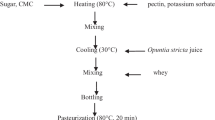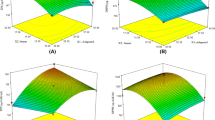Abstract
In this study the effect of sweeteners with low glycemic index and non-cariogenic characteristics (isomaltulose, oligofructose and tagatose) in jelly prepared with citrus juice has been evaluated considering a citrus jelly formulated with sucrose as reference. The soluble solids, moisture content, pH, water activity, antioxidant capacity, optical and mechanical properties of jelly made using different sweeteners was determined during storage. Besides, mesophilic aerobics and moulds and yeasts was also counted to determine their stability over time. Sensory evaluation of the citrus jelly has also been done. The results showed the antioxidant activity decreased during storage in all formulations. Tagatose increased lightness whereas coordinates a*, b* and chrome of all the jellies prepared using new sweeteners were lower than jellies with sucrose. However, citrus jelly with only oligofructose or tagatose or with the mixture of isomaltulose and tagatose were most closely resembled to the control jelly with respect to mechanical properties. Jelly prepared with the combination of isomaltulose and tagatose in equal proportions obtained the best score in the sensorial analysis.




Similar content being viewed by others
References
Álvarez J, Pastoriza S, Alonso-Olalla R, Delgado-Andrade C, Rufián-Henares JA (2014) Nutritional and physicochemical characteristic of commercial Spanish citrus juices. Food Chem 164:396–405
AOAC (2000) Official methods of analysis of AOAC international, 17th edn. Gaithersburg, MD
Calzada-León R, Ruiz-Reyes ML, Altamirano-Bustamante N, Padrón-Martínez MM (2013) Features of the noncaloric sweeteners and their use in children. Acta Pediatr Méx 34(3):141–153
Chacón-Villalobos A (2006) Current perspectives agribusiness oligofructosaccharides (FOS). Agron Mesoam 17(2):265–286
De Oliva-Neto P, Menão PTP (2009) Isomaltulose production from sucrose by protaminobacter rubrum immobilized in calcium alginate. Bioresour Technol 100:252–4256
de Queiroz Pane D, Dias CB, Meinhart AD, Ballus CA, Godoy HT (2015) Evaluation of the sweetener content in diet/light/zero foods and drinks by HPLC-DAD. J Food Sci Tech 52(11):6900–6913
Edwards WP (2002) The science of goodies. Acribia S.A, Spain
Food and Drug Administration (FDA) (2005) GRAS Notification Isomaltulose (PALATINOSE). http://www.fda.gov/ucm/groups/fdagov-public/@fdagovfoodsgen/documents/document/ucm268989.pdf. Accessed 12 July 2015
Food and Drug Administration (FDA) (2010) GRAS Notification Tagatose. GRN No.352.http://www.fda.gov/ucm/groups/fdagov-public/@fdagov-foods-gen/documents/document/ucm269560.pdf. Accessed 12 July 2015
Food and Drug Administration (FDA) (2011) GRAS Notification Oligofructose. GRN No.392. http://www.fda.gov/ucm/groups/fdagov-public/@fdagov-foodsgen/documents/document/ucm277112.pdf. Accessed 12 July 2015
GME (2015) Gelatine manufactured Europe gelatine properties. http://www.gelatine.org/en/about-gelatine/properties.html. Accessed 12 July 2015
ISO (2003) Sensory analysis. Guidelines for the use of quantitative response scales [ref. no.ISO 4121:2003]. International Organization for Standardization, Geneva
ISO (2008) Sensory analysis Vocabulary [ref. no.ISO 5492:2008]. International Organization for Standardization, Geneva
Ledur MJ, Tessaro I, Zapata CP (2013) Physicochemical characterization of Saccharides Powder obtained from Yacon Roots (Smallanthus sonchifolius) by membrane technology. Braz Arch Biol Technol 56(6):1024–1033
Levin GV (2002) Tagatose, the new GRAS sweetener and health product. J Med Food 5(1):23–36
Lina BAR, Jonker G, Kozianowski G (2002) Isomaltulose (Palatinose review of biological and toxicologycal studies). Food Chem Toxicol 40(10):1375–1381
O’Donnell K, Kearsley M (2012) Sweeteners and sugar alternatives in food technology, 2nd edn. Wiley, Chichester
Oh DK (2007) Tagatose: properties, applications, and biotechnological processes. Appl Microb Biotechnol 76(1):1–8
Pacual MR, Calderón-Pascual V (2000) Food Microbiology. Analytical methodology for foods and drinks, 2nd edn. Diaz de Santos, Madrid
Peinado I, Rosa E, Heredia A, Andrés A (2012) Rheological characteristics of healthy sugar substituted spreadable strawberry product. J Food Eng 113(3):365–373
Peinado I, Rosa E, Heredia A, Escriche I, Andrés A (2013) Optical, mechanical and sensorial properties of strawberry spreadable products formulated with isomaltulose. Food Bioprocess Tech 6(9):2353–2364
Periche A, Heredia A, Escriche I, Andrés A, Castelló ML (2014) Optical, mechanical and sensory properties of based-isomaltulose gummy confections. Food Biosci 7:37–44
Periche A, Heredia A, Escriche I, Andrés A, Castelló ML (2015a) Potential use of isomaltulose to produce healthier marshmallows. LWT-Food Sci Technol 62(1):605–612
Periche Á, Castelló ML, Heredia A, Escriche I (2015b) Stevia rebaudiana, Oligofructose and isomaltulose as sugar replacers in Marshmallows: stability and antioxidant properties. J Food Process Preserv. doi:10.1111/jfpp.12653
Petersen-Skytte U (2006) Tagatose. In: Mitchell H (ed) Sweeteners and sugar alternatives in food technology. Blackwell Publishing, Oxford, pp 262–292
Pimentel TC, Madrona GS, Prudencio SH (2015) Probiotic clarified apple juice with oligofructose or sucralose as sugar substitutes: sensory profile and acceptability. LWT–Food. Sci Technol 62(1):838–846
Rababah TM, Al-Mahasneh MA, Kilani I, Yang W, Alhamad MN, Ereifeja E, Al-U’datta M (2011) Effect of jam processing and storage on total phenolics, antioxidant activity, and anthocyanins of different fruits. J Sci Food Agric 91:1096–1102
Rubio-Arraez S, Sahuquillo S, Capella JV, Ortolá MD, Castelló ML (2015) Influence of healthy sweeteners (Tagatose and Oligofructose) on the physicochemical characteristics of orange marmalade. J Texture Stud 46(4):272–280
Shahidi F, Liyana-Pathirana CM, Wall DS (2006) Antioxidant activity of white and black sesame seeds and their hull fractions. Food Chem 99(3):478–483
Shukla V, Kandra P (2015) Development, physico-chemical and sensory evaluation of natural nutra candy. J Food Sci Tech Mys 52(11):7535–7539
Taylor TP, Fasina O, Bell LN (2008) Physical properties and consumer liking of cookies prepared by replacing sucrose with tagatose. J Food Sci 73(3):145–151
Van Den Heuvel EGHM, Muys T, Van Dokkum W, Schaafsma G (1999) Oligofructose stimulates calcium absorption in adolescents. Am J Clinic Nutr 69:544–548
Vastenavond CM, Bertelsen H, Hansen SJ, Laursen RS, Saunders J, Eriknauer K (2012) Tagatose (D-tagatose). In: Nabors L (ed) Alternative sweeteners. Boca Ratón, Florida, USA, p 197–222
Zeng Y, Zhang X, Guan Y, Sun Y (2012) Enzymatic hydrolysates from tuna backbone and the subsequent Maillard reaction with different ketohexoses. Int J Food Sci Technol 47:1293–1301
Acknowledgments
The authors would like to thank the Serigó-Andrés family for donating the raw materials, and also the GVA projects GV/2013/029, GV/2014/012 as well as the Universitat Politècnica de València (Spain) for the financial support given to this research study (UPV PAID-06-12 SP20120889).
Author information
Authors and Affiliations
Corresponding author
Electronic supplementary material
Below is the link to the electronic supplementary material.
Rights and permissions
About this article
Cite this article
Rubio-Arraez, S., Capella, J.V., Castelló, M.L. et al. Physicochemical characteristics of citrus jelly with non cariogenic and functional sweeteners. J Food Sci Technol 53, 3642–3650 (2016). https://doi.org/10.1007/s13197-016-2319-4
Revised:
Accepted:
Published:
Issue Date:
DOI: https://doi.org/10.1007/s13197-016-2319-4




